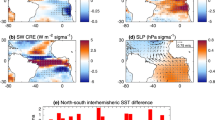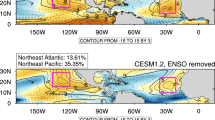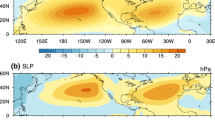Abstract
Climate modes of variability over the Atlantic and Pacific may be amplified by a positive feedback between sea-surface temperature (SST) and marine boundary layer clouds. However, it is well known that climate models poorly simulate this feedback. Does this deficiency contribute to model-to-model differences in the representation of climate modes of variability? Over both the North Atlantic and Pacific, typical summertime interannual to interdecadal SST variability exhibits horseshoe-like patterns of co-located anomalies of shortwave cloud radiative effect (CRE), low-level cloud fraction, SST, and estimated inversion strength over the subtropics and midlatitudes that are consistent with a positive cloud feedback. During winter over the midlatitudes, this feedback appears to be diminished. Models participating in the Coupled Model Intercomparison Project phase 5 that simulate a weak feedback between subtropical SST and shortwave CRE produce smaller and less realistic amplitudes of summertime SST and CRE variability over the northern oceans compared to models with a stronger feedback. The change in SST amplitude per unit change in CRE amplitude among the models and observations may be understood as the temperature response of the ocean mixed layer to a unit change in radiative flux over the course of a season. These results highlight the importance of boundary layer clouds in interannual to interdecadal atmosphere–ocean variability over the northern oceans during summer. The results also suggest that deficiencies in the simulation of these clouds in coupled climate models contribute to underestimation in their simulation of summer-to-summer SST variability.








Similar content being viewed by others
References
Alexander M (2010) Extratropical air–sea interaction, sea surface temperature variability, and the Pacific Decadal Oscillation. Climate dynamics: why does climate vary? pp 123–148
Bellomo K, Clement A, Mauritsen T, Rädel G, Stevens B (2014) Simulating the role of subtropical stratocumulus clouds in driving Pacific climate variability. J Clim 27(13):5119–5131
Bellomo K, Clement AC, Mauritsen T, Rädel G, Stevens B (2015) The influence of cloud feedbacks on equatorial Atlantic variability. J Clim 28(7):2725–2744
Bellomo K, Clement AC, Murphy LN, Polvani LM, Cane MA (2016) New observational evidence for a positive cloud feedback that amplifies the Atlantic Multidecadal Oscillation. Geophys Res Lett 43(18):9852–9859
Bony S, Dufresne J (2005) Marine boundary layer clouds at the heart of tropical cloud feedback uncertainties in climate models. Geophys Res Lett 32(20):L20806
Bretherton CS (2015) Insights into low-latitude cloud feedbacks from high-resolution models. Phil Trans R Soc A 373(2054):20,140,415
Brown PT, Lozier MS, Zhang R, Li W (2016) The necessity of cloud feedback for a basin-scale Atlantic Multidecadal Oscillation. Geophys Res Lett 43(8):3955–3963
Burgman R, Clement AC, Mitas C, Chen J, Esslinger K (2008) Evidence for atmospheric variability over the Pacific on decadal timescales. Geophys Res Lett 35(1):L01704
Cassou C, Deser C, Terray L, Hurrell JW, Drévillon M (2004) Summer sea surface temperature conditions in the north Atlantic and their impact upon the atmospheric circulation in early winter. J Clim 17(17):3349–3363
Cayan DR (1992) Latent and sensible heat flux anomalies over the northern oceans: driving the sea surface temperature. J Phys Oceanogr 22(8):859–881
Clement AC, Burgman R, Norris JR (2009) Observational and model evidence for positive low-level cloud feedback. Science 325(5939):460–464
Cronin MF, Bond NA, Farrar JT et al (2013) Formation and erosion of the seasonal thermocline in the Kuroshio extension recirculation Gyre. Deep sea research part II: topical studies. Oceanography 85:62–74
de Boyer Montégut C, Madec G, Fischer AS, Lazar A, Iudicone D (2004) Mixed layer depth over the global ocean: an examination of profile data and a profile-based climatology. J Geophys Res 109(C12)
Dee D, Uppala S, Simmons A, Berrisford P, Poli P, Kobayashi S, Andrae U, Balmaseda M, Balsamo G, Bauer P et al (2011) The Era-Interim reanalysis: configuration and performance of the data assimilation system. Q J R Meteorol Soc 137(656):553–597
Deser C, Blackmon ML (1993) Surface climate variations over the North Atlantic Ocean during winter: 1900–1989. J Clim 6(9):1743–1753
Evan AT, Allen RJ, Bennartz R, Vimont DJ (2013) The modification of sea surface temperature anomaly linear damping time scales by stratocumulus clouds. J Clim 26(11):3619–3630
Fan M, Schneider EK (2012) Observed decadal North Atlantic tripole SST variability. Part I: weather noise forcing and coupled response. J Atmos Sci 69(1):35–50
Garay MJ, de Szoeke SP, Moroney CM (2008) Comparison of marine stratocumulus cloud top heights in the southeastern Pacific retrieved from satellites with coincident ship-based observations. J Geophys Res 113:D18. doi:10.1029/2008JD009975
Klein SA, Hartmann DL (1993) The seasonal cycle of low stratiform clouds. J Clim 6(8):1587–1606
Loeb NG, Wielicki BA, Doelling DR, Smith GL, Keyes DF, Kato S, Manalo-Smith N, Wong T (2009) Toward optimal closure of the Earth’s top-of-atmosphere radiation budget. J Clim 22(3):748–766
Mantua NJ, Hare SR, Zhang Y, Wallace JM, Francis RC (1997) A Pacific interdecadal climate oscillation with impacts on salmon production. Bull Am Meteorol Soc 78(6):1069–1079
Myers TA, Norris JR (2013) Observational evidence that enhanced subsidence reduces subtropical marine boundary layer cloudiness. J Clim 26(19):7507–7524
Myers TA, Norris JR (2015) On the relationships between subtropical clouds and meteorology in observations and CMIP3 and CMIP5 models. J Clim 28(8):2945–2967
Norris JR, Evan AT (2015) Empirical removal of artifacts from the ISCCP and PATMOS-x satellite cloud records. J Atmos Ocean Technol 32(4):691–702
Norris JR, Zhang Y, Wallace JM (1998) Role of low clouds in summertime atmosphere–ocean interactions over the North Pacific. J Clim 11(10):2482–2490
Qu X, Hall A, Klein SA, Caldwell PM (2014) On the spread of changes in marine low cloud cover in climate model simulations of the 21st century. Clim Dyn 42(9):2603–2626
Reynolds RW, Rayner NA, Smith TM, Stokes DC, Wang W (2002) An improved in situ and satellite SST analysis for climate. J Clim 15(13):1609–1625
Rossow WB, Schiffer RA (1999) Advances in understanding clouds from ISCCP. Bull Am Meteorol Soc 80(11):2261–2287
Saravanan R (1998) Atmospheric low-frequency variability and its relationship to midlatitude SST variability: studies using the NCAR Climate System Model. J Clim 11(6):1386–1404
Stephens GL, Li J, Wild M, Clayson CA, Loeb N, Kato S, L’Ecuyer T, Stackhouse PW Jr, Lebsock M, Andrews T (2012) An update on Earth’s energy balance in light of the latest global observations. Nat Geosci 5(10):691–696
Sun M, Doelling DR, Raju RI, Nguyen LC, Loeb NG (2010) The CERES ISCCP-D2like cloud and radiative property data product. AGU Fall Meeting Abstracts
Tanimoto Y, Xie SP (2002) Inter-hemispheric decadal variations in SST, surface wind, heat flux and cloud cover over the Atlantic Ocean. J Meteorol Soc Jpn 80(5):1199–1219
Taylor KE, Stouffer RJ, Meehl GA (2012) An overview of CMIP5 and the experiment design. Bull Am Meteorol Soc 93(4):485–498
Vimont DJ, Battisti DS, Hirst AC (2001) Footprinting: a seasonal connection between the tropics and mid-latitudes. Geophys Res Lett 28(20):3923–3926
Wang H, Kumar A, Wang W, Xue Y (2012) Seasonality of the Pacific Decadal Oscillation. J Clim 25(1):25–38
Wood R (2012) Stratocumulus clouds. Mon Weather Rev 140(8):2373–2423
Wood R, Bretherton CS (2006) On the relationship between stratiform low cloud cover and lower-tropospheric stability. J Clim 19(24):6425–6432
Yuan T, Oreopoulos L, Zelinka M, Yu H, Norris JR, Chin M, Platnick S, Meyer K (2016) Positive low cloud and dust feedbacks amplify tropical North Alantic Multidecadal Oscillation. Geophys Res Lett 43(3):1349–1356
Zhang Y, Rossow WB, Lacis AA, Oinas V, Mishchenko MI (2004) Calculation of radiative fluxes from the surface to top of atmosphere based on ISCCP and other global data sets: refinements of the radiative transfer model and the input data. J Geophys Res 109:D19105. doi:10.1029/2003JD004457
Acknowledgements
This study was funded by NOAA’s Climate Program Office, Climate Variability and Predictability Program Award NA14OAR4310278. The research was partly carried out at the Jet Propulsion Laboratory, California Institute of Technology, under a contract with NASA. CERES data were obtained from the NASA Langley Research Center CERES ordering tool at http://ceres.larc.nasa.gov/. ISCCP data were downloaded from the Atmospheric Science Data Center located at NASA Langley Research Center. Joel Norris kindly provided the corrected ISCCP data. ERA-Interim data were downloaded from the ECMWF data server at http://apps.ecmwf.int/datasets/. The authors thank both the World Climate Research Programme Working Group on Coupled Modeling, which is responsible for CMIP, and the climate modeling groups for producing and making available their model output. Lastly, the authors thank three anonymous reviewers for their thoughtful comments that led to improvements in the manuscript.
Author information
Authors and Affiliations
Corresponding author
Electronic supplementary material
Below is the link to the electronic supplementary material.
Rights and permissions
About this article
Cite this article
Myers, T.A., Mechoso, C.R. & DeFlorio, M.J. Coupling between marine boundary layer clouds and summer-to-summer sea surface temperature variability over the North Atlantic and Pacific. Clim Dyn 50, 955–969 (2018). https://doi.org/10.1007/s00382-017-3651-8
Received:
Accepted:
Published:
Issue Date:
DOI: https://doi.org/10.1007/s00382-017-3651-8




